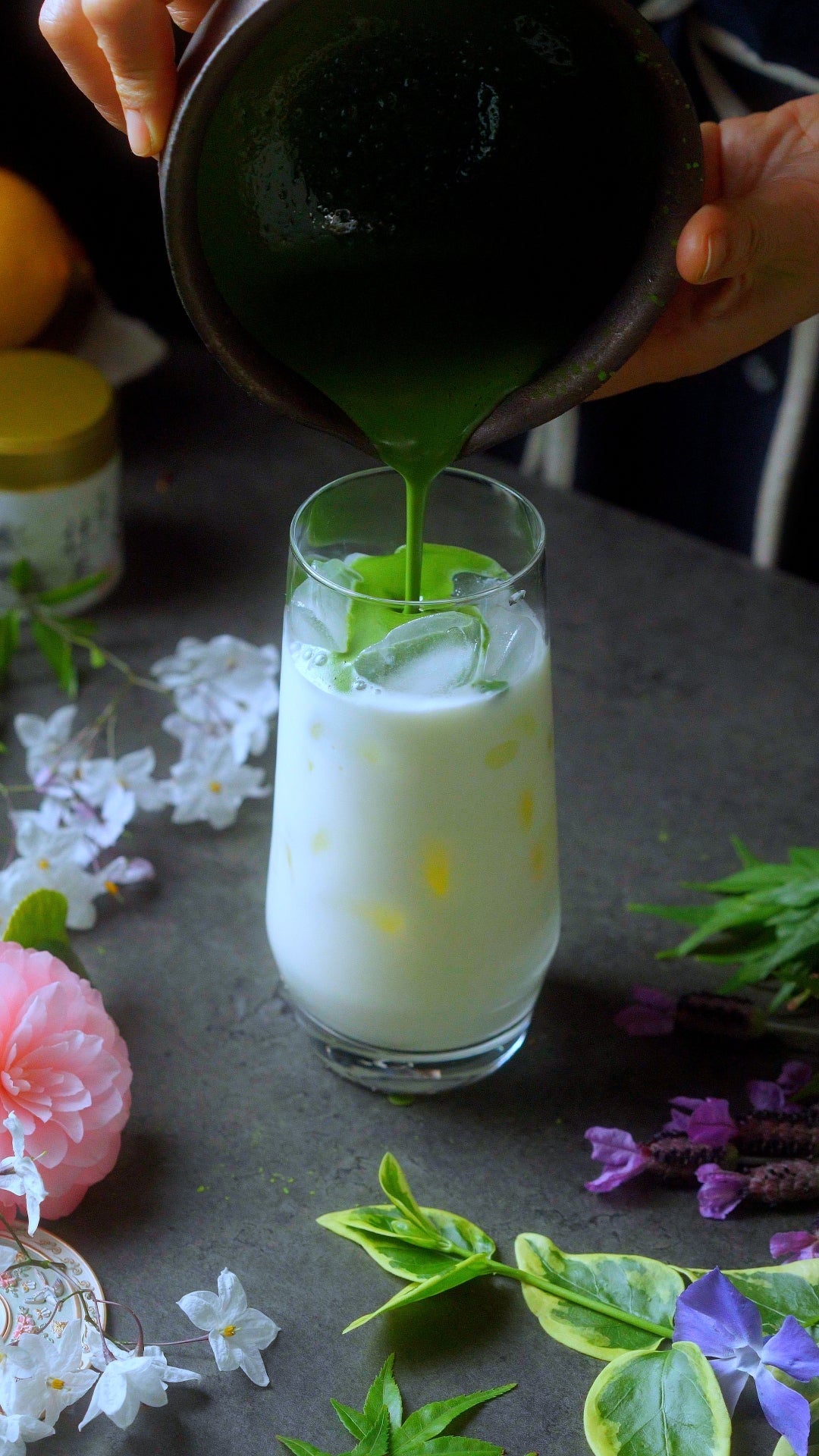
Unveiling Starbucks' Matcha Magic: A Deep Dive into Matcha Lattes, Green Tea Drinks, and Their Nutritional Benefits!
Share
Stepping into a Starbucks is like entering a world of flavor and creativity, and at the heart of its vibrant menu lies the enchanting allure of matcha. Join us as we unveil the magic of Starbucks’ matcha lattes and green tea drinks, where each sip transports you to a realm of rich tradition and modern delight. Matcha, celebrated for its vibrant green hue and tantalizing taste, is not just a trend; it’s a superfood packed with powerful antioxidants and a gentle energy boost. From the creamy sweetness of a matcha latte to the refreshing zest of green tea, there's a soothing option for every palate. In this article, we’ll explore the variety of matcha-based beverages Starbucks offers and delve into their nutritional benefits, revealing why these green delights deserve a prominent spot in your daily routine. Get ready to discover the irresistible combination of taste and wellness that Starbucks’ matcha magic provides!
✅ Why You Can Trust Us
We’ve worked with artisanal tea farmers in Japan for over 7 years
Our matcha is always ceremonial-grade and single-origin
We’ve helped over 8,000 customers create a mindful matcha habit
Every product is tested, tasted, and used by our own team — we only sell what we drink
Table of Content
The History of Matcha in Japanese Culture
Matcha, a finely ground powder of specially grown and processed green tea leaves, has deep roots in Japanese culture. Its cultivation began over a thousand years ago when Buddhist monks brought tea seeds from China to Japan. These monks discovered that consuming matcha helped them maintain a calm alertness during long meditation sessions. Thus, matcha became an integral part of Japanese Zen Buddhism.
The traditional Japanese tea ceremony, known as "chanoyu" or "sado," centers around the preparation, serving, and consumption of matcha. This ritualistic practice emphasizes mindfulness, respect, and tranquility, reflecting the spiritual significance of matcha in Japanese culture. Over time, matcha transcended religious contexts and became a symbol of Japanese hospitality, enjoyed during social gatherings and special occasions.
Today, matcha continues to be revered in Japan for its unique flavor and health benefits. The meticulous process of cultivating shade-grown tea leaves, known as "tencha," and grinding them into a fine powder ensures that matcha retains its vibrant green color and potent nutrients. This rich history and reverence for matcha have laid the foundation for its global popularity, including its prominent place on Starbucks' menu.

What Makes Starbucks' Matcha Lattes Unique?
Starbucks' matcha lattes stand out for their perfect balance of creamy sweetness and earthy matcha flavor. The secret lies in the high-quality matcha powder sourced from Japan, ensuring an authentic taste experience. Unlike traditional matcha, which is whisked with hot water, Starbucks' matcha lattes are crafted by blending matcha powder with steamed milk, creating a velvety and indulgent beverage.
One of the distinguishing features of Starbucks' matcha lattes is their versatility. Customers can choose from a variety of milk options, including almond, soy, coconut, and oat milk, catering to different dietary preferences and enhancing the flavor profile. The result is a customizable drink that retains the essence of matcha while offering a personalized experience.
Moreover, Starbucks' commitment to innovation is evident in their seasonal matcha offerings. From the Matcha Green Tea Frappuccino to the Iced Matcha Lemonade, these creative concoctions provide refreshing alternatives to the classic matcha latte. Whether you prefer your matcha hot or cold, Starbucks ensures that every sip is a delightful journey of taste and tradition.

“When you drink tea, just drink tea.”
— D.T. Suzuki
Exploring Starbucks' Green Tea Lineup — Upgraded to Matcha
Ever wondered how to recreate your favorite Starbucks green tea drinks at home—but elevate them with real matcha? Here’s how you can transform the classics using ceremonial-grade powder and clean ingredients:
Iced Matcha Latte
Blend 1 tsp ceremonial matcha with 3 oz hot (not boiling) water. Add 1 cup of your preferred milk, shake well with ice.Matcha Frappuccino
Blend 1 tsp matcha, 1/2 cup whole milk, 1/2 cup ice, a touch of vanilla, and your preferred sweetener for a creamy frozen treat.Iced Matcha Lemonade
Mix 1 tsp matcha with 3 oz water, then combine with 1/2 cup fresh lemon juice and simple syrup. Shake over ice.Emperor’s Matcha Mist
Shake 1/2 tsp matcha with cold water and a small pinch of sea salt. Pure, refreshing, and boldly minimal.
These DIY recipes preserve the essence of Starbucks’ green tea drinks—but with upgraded ingredients and full flavor clarity. A perfect way to bring your favorite café moment into your own kitchen.

Keto-Friendly Matcha Versions
Watching your carbs? You can still enjoy matcha magic—without the sugar crash. Here are keto-optimized remakes of Starbucks favorites:
-
Keto Iced Matcha Latte
1 tsp ceremonial matcha
3 oz hot water (around 175°F)
1/2 cup unsweetened almond milk
2 tbsp heavy cream
Optional: a few drops of monk fruit or stevia
→ Shake over ice for a creamy, satisfying low-carb latte.
-
Keto Matcha Frappuccino
1 tsp matcha
1/2 cup heavy cream
1/2 cup ice
1/4 cup unsweetened almond milk
1–2 tsp monk fruit sweetener
→ Blend until smooth and thick. Top with whipped cream if you’re feeling indulgent.
-
Keto Iced Matcha Lemonade
1 tsp matcha
3 oz filtered water
1/2 cup fresh lemon juice
Monk fruit syrup to taste
→ Shake vigorously over ice for a bright, tangy refreshment.
-
Minimalist Matcha (Zero-Sugar Zen)
1/2 tsp matcha
8 oz cold water
A pinch of sea salt (optional)
→ No sweetness, no cream—just pure clarity.
These recipes stay under 3–5g net carbs per serving , depending on sweetener and milk choice. They deliver matcha’s benefits—without breaking ketosis.
Nutritional Benefits of Matcha and Green Tea

Matcha and green tea are celebrated for their impressive nutritional profiles, making them a valuable addition to any diet. One of the standout features of matcha is its high concentration of antioxidants, particularly catechins. These compounds help combat oxidative stress, reduce inflammation, and support overall health. The most potent catechin in matcha, epigallocatechin gallate (EGCG), has been linked to various health benefits, including improved heart health and enhanced metabolism.
In addition to antioxidants, matcha is a rich source of vitamins and minerals. It contains vitamins A, C, and E, which are essential for immune function, skin health, and overall well-being. The presence of L-theanine, an amino acid unique to tea, contributes to matcha's ability to promote relaxation and mental clarity without the jitters associated with caffeine.
Green tea, including matcha, also boasts a range of health benefits. Regular consumption of green tea has been associated with reduced risk of chronic diseases, such as cardiovascular disease and type 2 diabetes. The combination of caffeine and L-theanine in green tea provides a gentle energy boost and improved cognitive function. Furthermore, green tea's natural compounds support weight management by enhancing fat oxidation and improving metabolic rate.

“True beauty is not to be found in perfection, but in the traces of the real.”
— Okakura Kakuzō
Comparing Matcha Lattes to Traditional Green Tea
While both matcha lattes and traditional green tea offer unique flavor experiences and health benefits, there are notable differences between the two. Matcha lattes are made by blending matcha powder with milk, resulting in a creamy and indulgent beverage. This preparation method enhances the rich, umami flavors of matcha and creates a comforting and satisfying drink.
Traditional green tea, on the other hand, involves steeping whole tea leaves in hot water, resulting in a lighter and more delicate flavor profile. The absence of milk allows the natural grassy and slightly sweet notes of green tea to shine through. This method of preparation preserves the tea's antioxidants and beneficial compounds, making it a refreshing and hydrating choice.
In terms of nutritional benefits, matcha lattes provide a concentrated dose of matcha's antioxidants and nutrients, thanks to the use of powdered tea leaves. However, the addition of milk and sweeteners can increase the calorie content. Traditional green tea, with its minimal calorie count and potent health benefits, offers a lighter alternative for those seeking a pure and refreshing beverage.



Conclusion: Embracing Matcha Magic at Starbucks
Conclusion
Matcha isn’t a performance. It isn’t perfection.
It’s a small green moment — where your hands slow down, your breath evens out, and something quiet inside you says: *“This is enough.”*
That’s all it needs to be.
So if your first cup was terrible — welcome. You’re in the right place.
Your matcha journey starts here.
If you want to buy yoga mats or books for beginners, you can check out more on our store

The Author: Chang Liu
I’ve worked in food and beverage for over 25 years — sourcing, tasting, building. But matcha is different. It’s not just a drink. For me, it’s a quiet companion. A way to return. A soft light on the path of practice, one cup at a time.
Products Featured In This Blog
Frequently Asked Questions
Can I get a sugar-free matcha latte at Starbucks?
Not directly—Starbucks' matcha powder contains sugar. Your best bet is to ask for an unsweetened green tea or customize using espresso bar ingredients.
What’s the best milk for a keto matcha latte?
Unsweetened almond milk or heavy cream works best. Both are low-carb and help create a creamy mouthfeel.
Does matcha have more caffeine than coffee?
Matcha has less caffeine per cup than coffee but delivers it more slowly and evenly—thanks to L-theanine.
Is matcha healthier than green tea?
Matcha is made from whole leaves, so you get more antioxidants and nutrients than steeped green tea.



